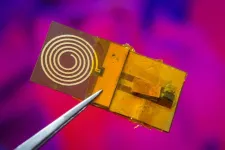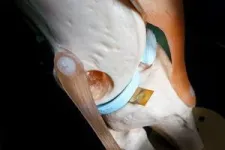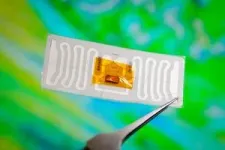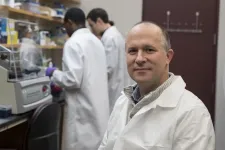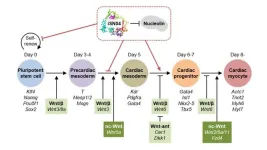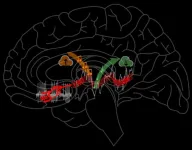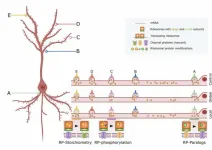(Press-News.org) Engineers at the University of California San Diego have developed electronic “stickers” that measure the force exerted by one object upon another. The force stickers are wireless, run without batteries and fit in tight spaces. That makes them versatile for a wide range of applications, from arming robots with a sense of touch to elevating the immersive experience of VR and AR, making biomedical devices smarter, monitoring the safety of industrial equipment, and improving the accuracy and efficiency of inventory management in warehouses.
They could be used, for example, in knee implants to measure the forces that implants exert on the joint. Having the ability to sense changes in these forces can be useful for monitoring an implant’s fit, as well as wear and tear. Force stickers could also be placed on the bottom of warehouse packages to measure the weight of their contents, acting as miniature scales for checking inventory.
“These force stickers could make technology more intelligent, interactive and intuitive,” said Dinesh Bharadia, professor of electrical and computer engineering at the UC San Diego Jacobs School of Engineering. “Humans, by nature, possess an inherent ability to sense force. This allows us to interact seamlessly with our surroundings and enables clinicians to perform delicate surgical procedures. Providing this force-sensing ability to electronic devices and medical implants could be a game-changer for many industries.”
A team led by Bharadia will present the new force stickers at the UbiComp 2023 conference, which will take place from Oct. 8 to 12 in Cancun, Mexico.
The force stickers consist of two main components. One is a tiny capacitor that is just a few millimeters thin and about the size of a grain of rice. The other component is a radiofrequency identification (RFID) sticker, which is a device that functions like a barcode that can be read wirelessly using radio signals. The researchers found a clever way to integrate these two components together so that they can measure the force applied by an object and communicate that information wirelessly to an RFID reader.
The capacitor is made of a soft polymer sheet sandwiched between two conductive copper strips. When an external force is applied, the polymer compresses, drawing the copper strips closer together, thereby increasing the electric charge in the capacitor.
This increase in electric charge as a result of applied force is key, the researchers show, because it creates changes in the signal transmitted by the RFID sticker. An RFID reader remotely measures these changes and translates them into a specific magnitude of applied force. This particular technique of creating changes in RFID signal enables the components within the force sticker to be miniaturized. In comparison, previous methods to create changes in RFID signal required components that are a thousand times larger in size.
Meanwhile, the RFID sticker runs on extremely low power by transmitting radio signals via a technique called backscattering. It takes incoming radio signals from an RFID reader, modifies the signals via electric changes induced by the capacitor, and then reflects the modified signals back to the reader, which deciphers and translates them into applied force.
As a result, the force stickers run on essentially no power. “The design is really simple with minimal electronics,” said study first author Agrim Gupta, an electrical and computer engineering Ph.D. student in Bharadia’s lab.
Another design feature is that the capacitor can be customized for various force ranges. By replacing the polymer layer with a softer or stiffer one, the capacitor can be tailored to measure smaller or larger forces, respectively.
To demonstrate, the researchers built and tested two types of force stickers. In one sticker, the capacitor was built with a super soft polymer to measure smaller forces, making it suitable for use in experiments in a model knee joint. Placed within the joint, the force sticker accurately measured different applied forces as the researchers pushed on the joint. The second sticker, in which the capacitor was constructed with a stiffer polymer, was tested in a warehouse packaging experiment. Attached to the underside of a box, it accurately measured the weight of varying quantities of objects placed in the box.
In tests, the force stickers were extremely durable. They withstood more than 10,000 force applications and remained consistently accurate. Additionally, they can be fabricated at low cost, with each sticker amounting to less than $2, the researchers noted.
“If we can commercialize this technology, we imagine that in the future a box of them could be sold inexpensively, like a box of Band-Aids,” said Gupta.
However, it is worth noting a limitation: these force stickers require a static environment to function effectively and do not perform optimally in highly dynamic surroundings. The researchers are actively addressing this issue as they seek to further improve the technology.
Moving forward, the researchers aim to make the force stickers readable by smartphones, which would eliminate the need for RFID readers.
Paper: “ForceSticker: Wireless, Batteryless, Thin & Flexible Force Sensors.” Co-authors include Daegue Park, Shayun Bashar, Cedric Girerd, Nagarjun Bhat, Siddhi Mundhra and Tania K. Morimoto, UC San Diego.
Medium Blog: https://medium.com/p/796294399c91/edit
This work was supported in part by the National Science Foundation (grant 1935329).
END
Wireless, battery-free electronic ‘stickers’ gauge forces between touching objects
2023-10-10
ELSE PRESS RELEASES FROM THIS DATE:
How to cope when your values clash with your co-workers’
2023-10-10
COLUMBUS, Ohio – In our increasingly polarized society, more people may find themselves in a workplace where they are one of the few conservatives or few liberals around.
A new study found that those whose values – political or otherwise – don’t match the majority in their organization felt they received less respect and as a result were less engaged at work. Moreover, their co-workers noticed their lack of engagement.
“It is a real issue that organizations face,” said Tracy Dumas, lead author of the study and associate professor of management and human resources at The Ohio State University’s ...
Source of electron acceleration and X-ray aurora of Mercury ̶ local chorus waves detected
2023-10-10
Background
Since Mercury is the closest planet to the Sun among the solar system planets, it is strongly influenced by the solar wind, a high-speed (several hundred km/s) stream of plasma blowing from the Sun. Explorations of Mercury was first carried out by the Mariner 10 spacecraft in 1974 and 1975, which revealed that Mercury has a magnetic field, and thus a magnetosphere, similar to that of Earth. In the 2000s, the MESSENGER spacecraft provided a detailed picture of the Mercury's magnetic field and magnetosphere, and revealed that Mercury's magnetic field center is shifted northward from the planet’s center by approximately ...
NIH provides $1.2 million for ambitious effort to battle antibiotic resistance
2023-10-10
University of Virginia researchers are working to outrace two dangerous germs known for quickly developing resistance to new antibiotics – and the scientists’ efforts could help us better combat antibiotic resistance more broadly.
A team led by Jason Papin, PhD, is developing sophisticated computer models of Staphylococcus aureus and Pseudomonas aeruginosa, two multi-drug resistant bacteria that infect thousands of Americans every year. The researchers will use their models to better understand the cellular processes and gene activity that make the bacteria ...
Researchers test large language model that preserves patient privacy
2023-10-10
OAK BROOK, Ill. – Locally run large language models (LLMs) may be a feasible option for extracting data from text-based radiology reports while preserving patient privacy, according to a new study from the National Institutes of Health Clinical Center (NIH CC) published in Radiology, a journal of the Radiological Society of North America (RSNA). LLMs are deep-learning models trained to understand and generate text in a human-like way.
Recently released LLM models such as ChatGPT and GPT-4 have garnered attention. However, they are not compatible with healthcare data due to privacy constraints.
“ChatGPT and GPT-4 are proprietary models that require the user ...
DNA aptamer finds novel application in regulating cell differentiation
2023-10-10
Generating specific cell lineages from induced pluripotent stem cells and embryonic stem cells is the holy grail of regenerative medicine. Guiding iPSCs toward a target cell line has garnered much attention, but the process remains challenging. Now, researchers from Japan have discovered that an anti-nucleolin DNA aptamer, iSN04, can determine a cell’s lineage during differentiation. By demonstrating the generation of cardiomyocytes from murine pluripotent stem cells, their concept shows promise as a regenerative therapy.
Self-renewal ...
Monitoring African copper and cobalt mining emissions from space
2023-10-10
Emissions associated with mining operations in Africa’s Copperbelt can be quantified from space, according to new research led by the National Center for Atmospheric Research (NCAR).
Mining for copper and cobalt in Africa has rapidly increased, the latter in response to growing global demand for electric vehicles, laptops, smartphones, and other devices that rely on lithium-ion batteries, the vast majority of which contain cobalt.
The new study is published in Geophysical Research Letters, ...
Study compares health information exchange data versus patient self-reports to measure cancer screening uptake
2023-10-10
INDIANAPOLIS – Knowing which populations are following cancer screening guidelines is important to public health officials and policy makers as well as researchers developing strategies to improve adherence. A recent study is one of the first to compare using health information exchange (HIE) data with patient self-reported data as a means of gathering this intelligence.
The researchers found that completeness of information differed by data source and screening test. HIE data provided more information than patient self-reports about ...
Seamlessly multiplexing memory storage and recall
2023-10-10
Every day we store memories, some of which we are able to recall later. But while we do so, do we keep on storing? Yes! We cannot afford to stop memory formation while we are retrieving prior ones. Imagine, for instance, that you are navigating the city while recalling last night’s events to a friend tagging along. Your brain must memorize aspects of the route even while you are in the story, so that you can find your way back later or reach your next destination.
We seem to perform this task without much conscious effort. Big deal, one could say, as we know that the brain has trillions of synaptic connections, so parallel processing ...
UNIST recognized for design excellence at IDEA 2023!
2023-10-10
The design concept of a disaster alert balloon, capable of changing its color like a chameleon, has been honored for its design excellence at the internationally renowned International Design Excellence Award (IDEA) 2023.
The awarded concept, named SAFEUP, serves as a hazard indicator, providing visual information about the condition of accident sites from a safe distance. Developed by Professor Chajoong Kim and his team in the Department of Design at UNIST, SAFEUP has received the ‘IDEA 2023’ Bronze Award in the category of Concepts & Speculative Design. The ...
The ribosome–depression link
2023-10-10
A group of ribosomal protein genes connect animal models of depression to human patients with major depressive disorder. In order to research depression treatments, scientists use a mouse model, inducing a state with similarities to depression though exposure to variable, unpredictable, and uncontrolled stressors over days or weeks. But is this state molecularly akin to what humans with major depressive disorder experience? To find out, Xiaolu Zhang, Mahmoud Ali Eladawi, and colleagues examine transcriptomics data from postmortem human brain tissue and from several mouse models of stress, seeking to pinpoint conserved ...
